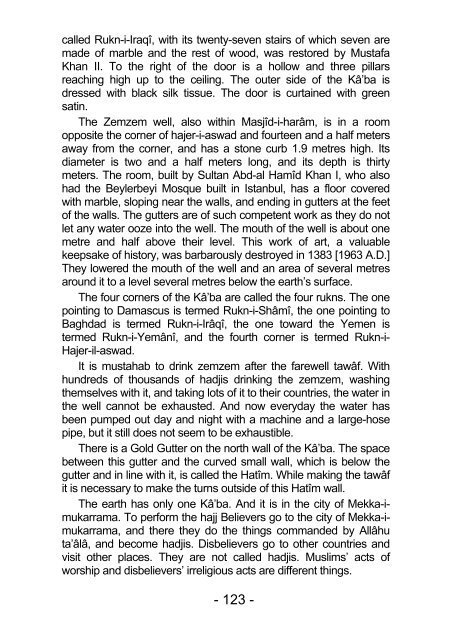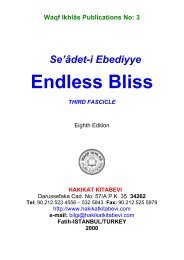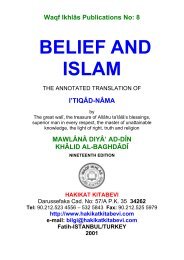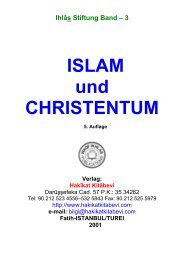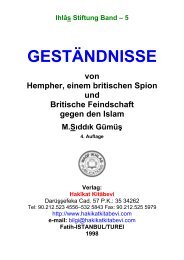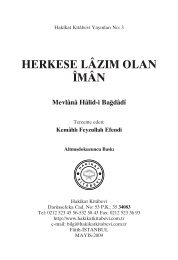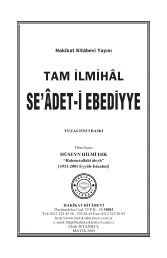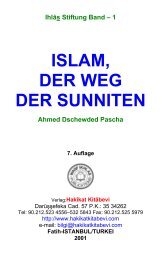5-Endless Bliss Fifth Fascicle - Hakikat Kitabevi
5-Endless Bliss Fifth Fascicle - Hakikat Kitabevi
5-Endless Bliss Fifth Fascicle - Hakikat Kitabevi
You also want an ePaper? Increase the reach of your titles
YUMPU automatically turns print PDFs into web optimized ePapers that Google loves.
called Rukn-i-Iraqî, with its twenty-seven stairs of which seven are<br />
made of marble and the rest of wood, was restored by Mustafa<br />
Khan II. To the right of the door is a hollow and three pillars<br />
reaching high up to the ceiling. The outer side of the Kâ’ba is<br />
dressed with black silk tissue. The door is curtained with green<br />
satin.<br />
The Zemzem well, also within Masjîd-i-harâm, is in a room<br />
opposite the corner of hajer-i-aswad and fourteen and a half meters<br />
away from the corner, and has a stone curb 1.9 metres high. Its<br />
diameter is two and a half meters long, and its depth is thirty<br />
meters. The room, built by Sultan Abd-al Hamîd Khan I, who also<br />
had the Beylerbeyi Mosque built in Istanbul, has a floor covered<br />
with marble, sloping near the walls, and ending in gutters at the feet<br />
of the walls. The gutters are of such competent work as they do not<br />
let any water ooze into the well. The mouth of the well is about one<br />
metre and half above their level. This work of art, a valuable<br />
keepsake of history, was barbarously destroyed in 1383 [1963 A.D.]<br />
They lowered the mouth of the well and an area of several metres<br />
around it to a level several metres below the earth’s surface.<br />
The four corners of the Kâ’ba are called the four rukns. The one<br />
pointing to Damascus is termed Rukn-i-Shâmî, the one pointing to<br />
Baghdad is termed Rukn-i-Irâqî, the one toward the Yemen is<br />
termed Rukn-i-Yemânî, and the fourth corner is termed Rukn-i-<br />
Hajer-il-aswad.<br />
It is mustahab to drink zemzem after the farewell tawâf. With<br />
hundreds of thousands of hadjis drinking the zemzem, washing<br />
themselves with it, and taking lots of it to their countries, the water in<br />
the well cannot be exhausted. And now everyday the water has<br />
been pumped out day and night with a machine and a large-hose<br />
pipe, but it still does not seem to be exhaustible.<br />
There is a Gold Gutter on the north wall of the Kâ’ba. The space<br />
between this gutter and the curved small wall, which is below the<br />
gutter and in line with it, is called the Hatîm. While making the tawâf<br />
it is necessary to make the turns outside of this Hatîm wall.<br />
The earth has only one Kâ’ba. And it is in the city of Mekka-imukarrama.<br />
To perform the hajj Believers go to the city of Mekka-imukarrama,<br />
and there they do the things commanded by Allâhu<br />
ta’âlâ, and become hadjis. Disbelievers go to other countries and<br />
visit other places. They are not called hadjis. Muslims’ acts of<br />
worship and disbelievers’ irreligious acts are different things.<br />
- 123 -


